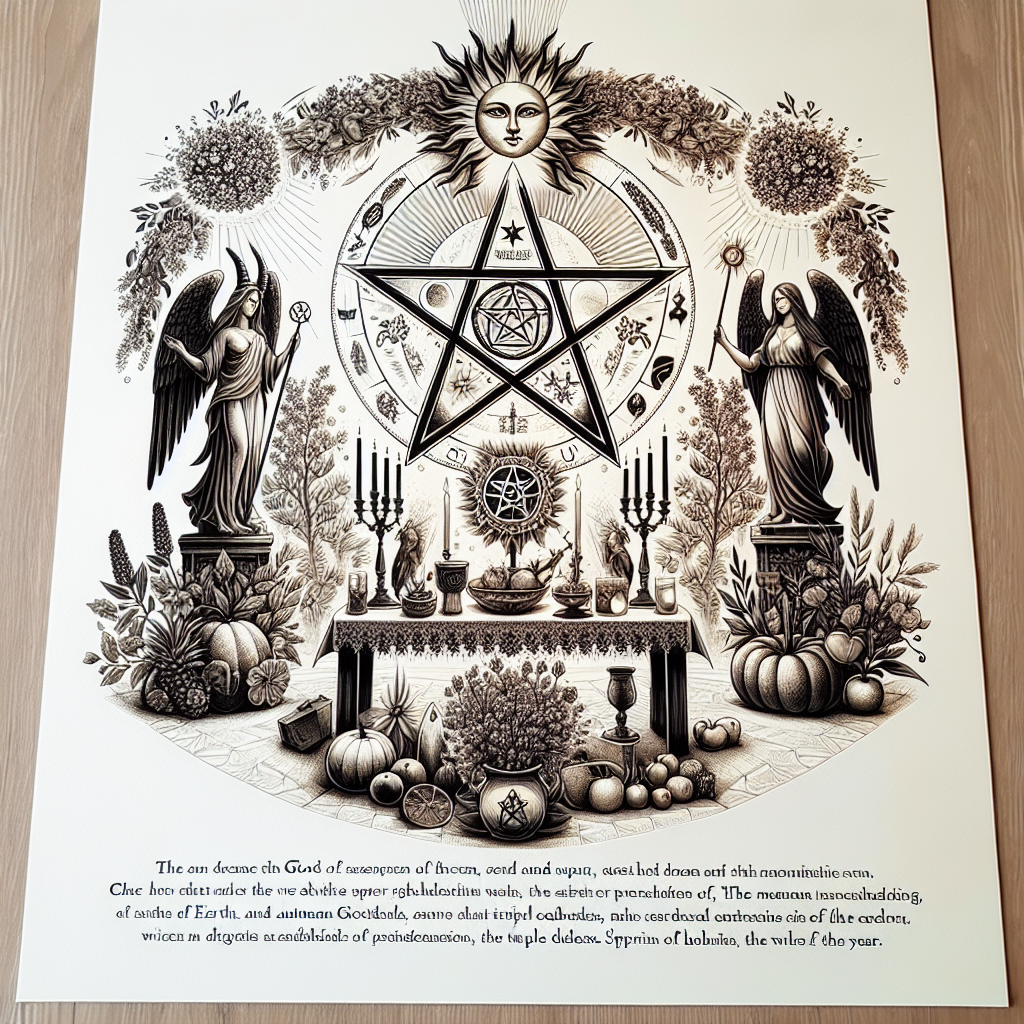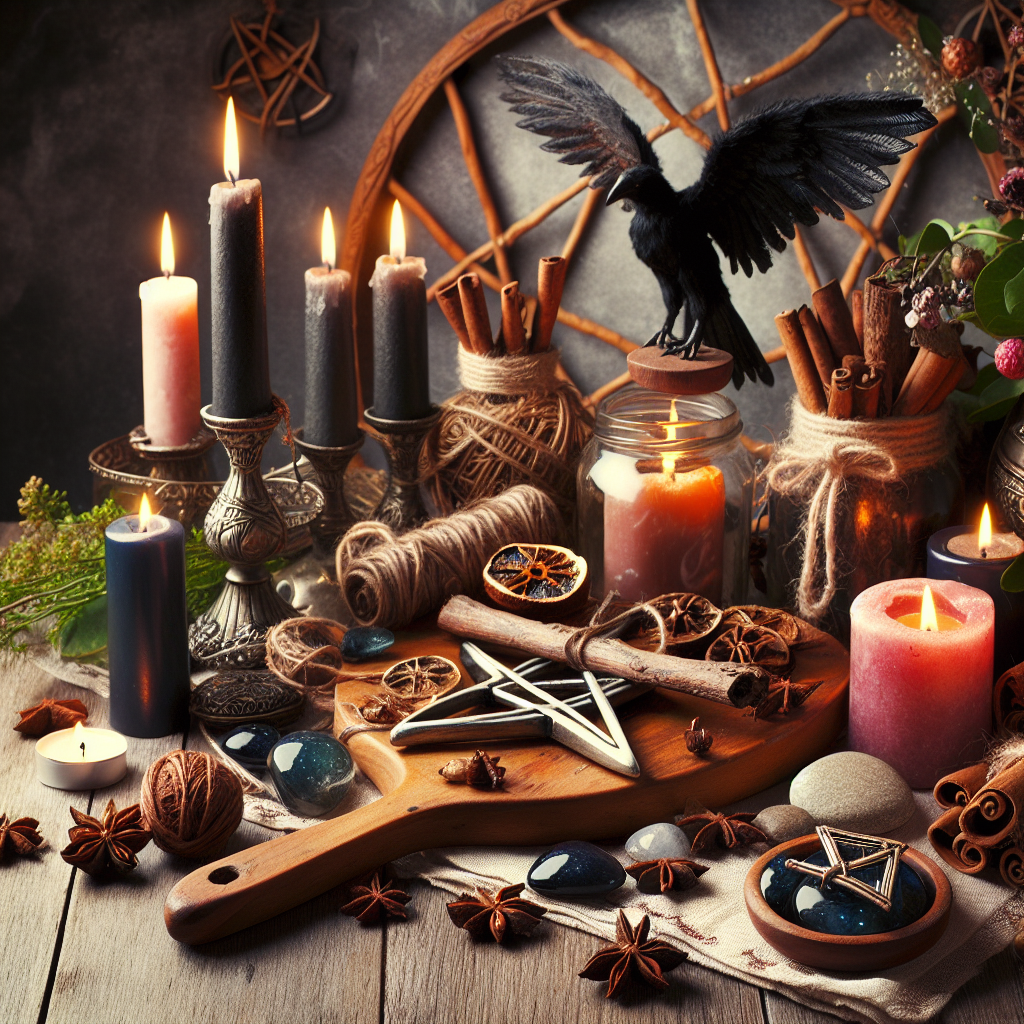As an Amazon Associate I earn from qualifying purchases.

Wicca, a modern pagan and witchcraft religion, was introduced during the mid-20th century and has since spread throughout various regions around the world, amassing followers who passionately adhere to its practices and celebrations. One particularly notable element within Wicca is the celebration of Wiccan holidays, also known as Sabbats, which are in tune with the seasons of the year, reflecting the religion’s connection to nature and the changing seasons. This cyclical celebration of eight Wiccan holidays, observed at key transitions of the solar year, is central to the Wiccan belief system, making it of significant interest to those who practice this faith and those who wish to understand its essence.
The origins of the Wiccan holidays traced back to pre-Christian, or even prehistoric times European festivals. The holidays are commonly referred to as Sabbats, which comprise four greater Sabbats and four lesser Sabbats. The greater Sabbats—Samhain, Imbolc, Beltane, and Lammas—are related to the Celtic agricultural cycle, occurring at the quarter points of the year. The lesser Sabbats—Yule, Ostara, Litha, and Mabon—are solar festivals, marking the solstices and equinoxes. These Sabbats are not only deeply ingrained in the traditions of Wicca, but they also hold profoundly sacred importance to its practitioners.
Modern Wicca’s celebrations of these holidays are a blend of historical customs, mythology, folklore, and ritual symbolism. Each Sabbat is characterized by unique rituals and ceremonies, often involving activities like feasting, dancing, singing, and storytelling. These rituals serve to connect practitioners with the natural rhythms and cycles of the earth, reinforcing the Wiccan belief of sacredness in all aspects of life. For Wiccans, by marking these eight powerful points in the solar year, they acknowledge the ever-changing world and the continuous cycle of birth, life, death, and rebirth—central tenets in the Wiccan faith.
Wicca currently exists as one of the fastest-growing religions in the United States, with an estimated 1.5 million people in the U.S identifying themselves as Wiccan, according to a 2014 Pew Research Center survey. This growth has led to an increased awareness and understanding of Wiccan traditions, fostering the sharing and exchange of this once mysterious and often misunderstood faith. Celebrating Wiccan holidays and marking the turn of the Wheel of the Year has become more mainstream, with many non-Wiccans taking part in honoring the earth’s cycles and incorporating the rich Wiccan symbolism into their own practices.
From a practical perspective, celebrating Wiccan holidays doesn’t have to be complicated or overwhelming. The holidays emphasize the turning of the seasons and the balance between light and darkness, conveying a simple yet profound respect for the natural world. Accordingly, the rituals observed can be as simple as lighting a candle during the winter solstice or as complex as organizing a festive Beltane Maypole dance. However one chooses to celebrate, the most important aspect is the recognition and honoring of the changing seasons, the sacredness of the earth, and the interconnectedness of all life. The path to understanding and embracing the Wiccan holidays encourages mindfulness, a deeper connection with nature, and a broadened perspective on life’s cyclical nature.
What are the Traditions of Celebrating Wiccan Holidays for Every Season?
The Wiccan holidays, also known as Sabbats, are an integral part of the Wiccan Wheel of the Year, marking seasonal changes and important day markers. Full of rich traditions, they embrace the continuous cycle of nature, invoking a deep sense of connectivity with the earth. They’re observed through a combination of private rituals, communal ceremonies, festive meals, and other symbolic activities. These celebrations imbue a sense of belonging and harmony for practitioners, providing spiritual enlightenment and emotional wellness. This article delves deeper into the intricacies of these celebrations, offering detailed analyses of each holiday and its associated rituals and practices, ensuring a comprehensive understanding that allows for full immersive participation for both novice and seasoned Wiccans.
Celebrating Wiccan Holidays: Traditions for Every Season
Celebrating Wiccan holidays, more commonly referred to as Sabbats, offers devotees of Wicca an opportunity to attune themselves with the earth’s cycles. These holidays are an essential component of Wiccan belief and practice, providing a structure for communal and solitary worship. They serve as a ceremonial expression of reverence for the various phases of life as encompassed by the changing seasons of Mother Earth.
SAMHAIN – OCTOBER 31ST
As the new year in the Wiccan calendar and one of the most spiritually significant Wiccan holidays, Samhain marks the end of the harvest and the beginning of the darker half of the year. Wiccans pay respect to the cycle of death and rebirth by using this time to remember ancestors and loved ones who have passed on. Typical traditions involve setting up an altar with pictures and mementos of the deceased. Many also leave food and drink offerings.
YULE – DECEMBER 21ST
On Yule, the winter solstice and the shortest day of the year, Wiccans celebrate the returning sun. The prevailing custom is the burning of the Yule log, a symbol of the rebirth of the Sun God. Also, the exchange of gifts, feasting, singing traditional yule songs, and adorning homes with evergreen branches are all part of the Yule celebration.
IMBOLC – FEBRUARY 2ND
Imbolc, on February 2nd, signifies the beginning of spring. Wiccans honor the goddess Brigid by performing rituals focusing on healing and fertility. Homes are commonly cleansed of the previous year’s energy, and new goals are set for the upcoming year.
OSTARA – MARCH 21ST
Celebrated in the Spring Equinox, Ostara is a celebration of the balance of light and dark and the coming of increased illumination. It is common to conduct rituals for growth, planting magical herbs, and to honor the goddess of the dawn, Eostre. Dyed eggs, the representative of fertility and new beginnings, are often used in the festivities.
BELTANE – MAY 1ST
Recognized for the onset of summer, Beltane, like Samhain, is a significant fire festival. Traditional activities include lighting bonfires, maypole dancing, and performing magic to foster growth. This holiday is known to be one of joy and merriment.
LITHA – JUNE 21ST
Litha, the summer solstice and longest day of the year, is a time of abundance. Wiccans honor the Sun God on this day and conduct rituals focusing on the strength and power of the sun and the bounty it provides.
LAMMAS – AUGUST 1ST
Lammas, or Lughnasadh, marks the beginning of the harvest season. Wiccans honor the grain god Lugh by baking bread in the shape of a man or a sun wheel and presenting it as an offering.
MABON – SEPTEMBER 21ST
The final harvest festival, Mabon, observed on the autumn equinox, is a time of giving thanks. Many people conduct rituals involving apples because they symbolize the food of the gods and immortality.
Behind every Wiccan holiday lies a rich tapestry of reverence for nature and the divine. Traditional practices offer Wiccans the chance to celebrate and appreciate the cycles of the earth and the metaphysical lessons they impart.
According to surveys, around 734,000 people in the USA identify as Wiccans, and these numbers are steadily growing. These individuals utilize Wiccan holidays as a means to stay connected with the divinity inherent in the natural world.
Q: What are some common Wiccan holidays?
A: The most common Wiccan holidays are the 8 Sabbats included in the Wheel of the Year, such as Samhain, Yule, Imbolc, Ostara, Beltane, Litha, Lughnasadh, and Mabon, which correspond with the seasons and natural cycles.
Q: How are Wiccan holidays celebrated?
A: Wiccan holidays are primarily celebrated through rituals, ceremonies, feasting, and connecting with nature. It depends on the particular tradition of the practitioner, as some may also include dancing, bonfires, or communal activities.
Q: What is the significance of the Wheel of the Year in Wicca?
A: The Wheel of the Year in Wicca symbolizes the annual cycle of the Earth’s seasons. Each of the eight points on the Wheel represents a specific holiday or Sabbat, marking a significant phase in this cycle.
Q: When is the Wiccan New Year?
A: The Wiccan New Year is celebrated on Samhain, which falls on October 31st. This holiday is considered a time of endings and beginnings, making it a spiritual “New Year” in many Wiccan traditions.
Q: Do all Wiccans celebrate every holiday on the Wheel of the Year?
A: It varies. While the Wheel of the Year and its Sabbats are integral to many Wiccan traditions, not all Wiccans celebrate every holiday. Practices can differ widely based on personal belief, regional traditions, and individual connection to each season’s significance.
Q: What is the importance of seasonal alignment in Wiccan holiday celebrations?
A: Aligning celebrations with the seasons allows Wiccans to feel more connected with nature and its rhythms. These holidays often mark significant agricultural or astronomical events that reflect the cycles of life, death, and rebirth.
Q: Can non-Wiccans participate in Wiccan holidays or celebrations?
A: Yes, non-Wiccans can participate in Wiccan holidays as long as they approach with respectful curiosity and are mindful of the traditions’ sacred nature. Some Wiccan rituals or gatherings may be private, so it’s always important to ask first.
Q: How can I learn more about specific Wiccan holidays and traditions?
A: Good sources of information include Wiccan books, online forums, community groups, or by engaging in conversation with practicing Wiccans. Be prepared to encounter variation, as Wiccan traditions can differ widely.
Q: Are Wiccan holidays based on ancient practices?
A: Many Wiccan holidays are indeed rooted in ancient cultures, particularly Celtic and Norse traditions. However, Wicca as we know it today is a relatively new religion that has adapted and absorbed aspects from many different spiritual paths.
Q: How can a beginner start incorporating Wiccan holidays into their practices?
A: Beginners can start slowly by choosing one or two holidays that resonate the most with them and engage in simple rituals, such as creating an altar, spending time in nature, or meditating. It’s recommended to gradually increase involvement and learning over time.
Summary of Wiccan Holidays And Traditions
Delving into the practice and tradition of Wiccan holidays allows one to connect to the cycle of nature and its seasons, creating a sense of grounding and mindfulness. These moments of celebration and reflection, known as Sabbats, occur at key points in the Earth’s journey around the sun. They tap into ancient wisdom that invites individuals to echo the rhythms of nature in their personal development and spiritual growth. Commemorating Yule, Ostara, Beltane, Litha, Lughnasadh, Mabon, and Samhain provide a rich tapestry of traditions that encourage reverence for our world’s divine natural processes and the elements that exist within each individual.
From the quiet, introspective period of Yule, the Wiccan year unfolds, reflecting an ongoing symphony of birth, growth, harvest, and calm. The spring equinox of Ostara ushers in new beginnings, while Beltane brings forth love, fertility and prosperity. Midsummer – Litha – pays homage to the sun at its zenith. As the year winds down, the harvest festivals of Lughnasadh and Mabon invite practitioners to reap the seeds they’ve sown, both literally and metaphorically. Lastly, Samhain ushers us into a period of introspection as the year draws to its close, marking an honoring of those who have passed on and the promise of nature’s rebirth in Yule. Immersing in these diverse Wiccan holidays can enlarge your understanding of self and surroundings, enabling you to live in greater harmony with nature’s rhythms.
Amazon and the Amazon logo are trademarks of Amazon.com, Inc, or its affiliates.


